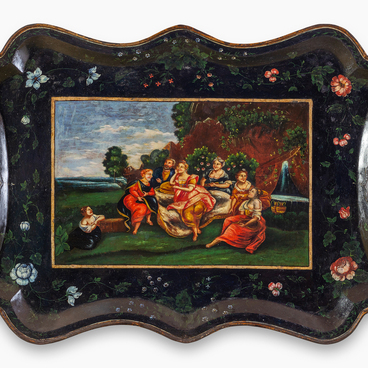In the 1980s, the artist Yelena Yuryevna Marchenko painted a genre scene on an old tray produced in the late 19th century. This work was commissioned for the exhibition of the Emalposuda (Enamelware) factory museum in Nizhny Tagil. The museum was established in 1982. At that time, the production and artistic quality of the trays were at their peak, and many tasks associated with the revival and development of the traditional Nizhny Tagil painting had already been completed.
The idea of decorating this tray was initiated by Gennady Petrovich Babin, the chief artist at the Emalposuda factory. He made a significant contribution by organizing a creative team of artists who designed genre scenes, lubok-style paintings, stencil patterns, and fruit and berry compositions.
The painting was based on the famous print “Peter the Great Rescues Fishermen on Lake Ladoga”. This choice was not random at all: the Nizhny Tagil craftsmen knew that there already was a similar tray. It was created in Zhostovo in the 1870s and was part of the collection of the State Russian Museum.
An old Soviet photograph of the Zhostovo tray was found in the collection of the All-Russian Museum of Decorative, Applied, and Folk Art. A 19th-century tray with a similar scene glorifying the feat of the Russian emperor can be found in the collection of the State Hermitage Museum. It depicts Peter the Great rescuing people during a flood.
The original painting was created in 1812 by the French history painter Charles de Steuben (1788–1856). It became very popular and inspired numerous similar artworks. The painting was copied by many other artists who used it to create not only engravings but also tapestries, clocks, and other items of decorative and applied arts.
The decorative pattern and the coats of arms of the Russian Empire on the tray from the Nizhny Tagil collection were also created by Yelena Yuryevna Marchenko. According to Gennady Petrovich Babin, these elements were designed with the help of Yuri Serafimovich Melentyev, the Minister of Culture of the RSFSR. Yuri Melentyev showed interest in the revival of the traditional Ural painting. A photographer who accompanied the minister assisted in choosing the motif and recommended samples of the coat of arms of the Russian Empire.


